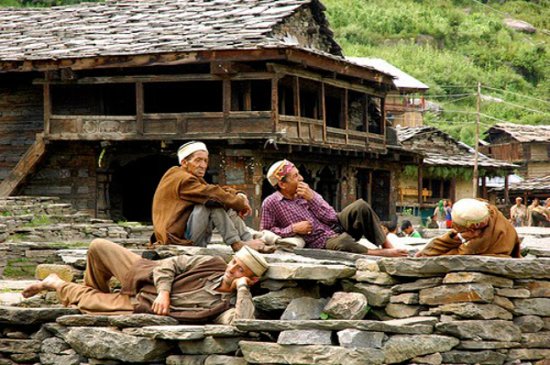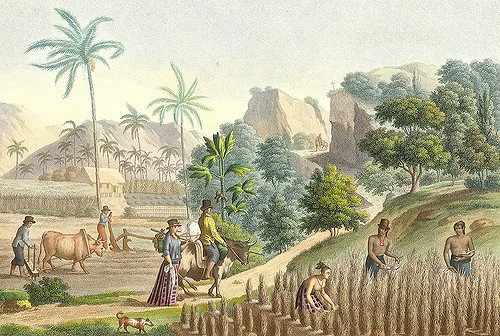Indian Villages Remains True From Being Self-Contained
Indian Villages Remains True From Being Self-Contained

Image Source
At point when overpopulation powers people from the Konkan or Malabar to labor in far off huge cities and to send money back home does the urban control make itself straightforwardly felt. Something else, the contact is fundamentally through visiting officials, who once in a while inconvenient themselves about the village aside from when taxes are financially past due. These days, the vote-begging politicians come once like clockwork, just before elections. This economy has clearly low commodity production per tenant.
A commodity is an article or object of utilization which goes under the control of a definitive consumer by trade. Whatever a man produces for himself or his family or other connection gathering and is then devoured inside the little gathering or is taken away without payment via landlord isn't a commodity. Some production requires specific technical information.
Despite the fact that the Indian village utilizes next to no metal, the villager needs pots, more often than not of earthenware. This implies a potter must be accessible. Likewise, a blacksmith to repair tools and manufacture plowshares, a carpenter for building houses and making the simple plows. The priest must serve whatever custom needs the village feels. He is generally a brahmin, however that isn't mandatory for certain lower cults. Certain occupations, for example, that of barber, or skinner of dead mammoths, are low yet the barber's errands and leather goods are fundamental.
This requires the nearness in the village of a barber and a leather worker of various castes. Regularly, each such profession forms a caste, the Indian substitute for the medieval guild. The great issue of the obviously independent Indian rural economy was to get the services of such essential artisans for each village despite the fact that they were isolated from the main part of the peasant villagers and from each other by caste.

Image Source
The typical villager couldn't work at these different trades, while the workers couldn't intermarry aside from inside a similar caste profession. One artisan household of each sort was the most that a normal village could manage. In the meantime transport was difficult and the thickness of commodity production was low. A settlement of blacksmiths or carpenters as commodity producers serving many different villages was unthinkable with the exception of at certain short periods of early Indian history.
Consistent payment for the artisans was in this way an issue that couldn't be illuminated by a barter economy simply on the premise of trade for value created, with a sporadic demand.
How the artisans initiated to serve villages?
The arrangement of this issue, smart in its own specific manner, was the backbone of the drowsy Indian village economy, particularly in the feudal period. The remainders of the system arc still to be found in the wide open, however cash payment relentlessly uproots the old method. Transport is less demanding, with the goal that a journey man barber or blacksmith is normal. Tins and metal pots have lessened the quantity of potters, who work oftener than not on the premise of production available to be purchased against cash.
Be that as it may, the potter does certain custom errands which may date from ancient urn burial and have been augmented to make him for all intents and purposes the priest to certain lower castes. The invention of the clayplaster in bone-setting is because of the Indian potter, similarly as plastic surgery to reestablish noses mangled in war or by ailment was a revelation of the fairly disdained barber. Both were honed broadly in the eighteenth century, the low caste status of the practitioners and hatred for science with respect to their betters averted full development as in the West.

Image Source
The separation inside the village is by caste, even past that amongst artisan and peasant or priest. At the point when there are backwoods near to one may at present observe people like the Kathkaris of the Western Ghats, or the Mundas and Oraons of Bihar who are scarcely out of the food-gathering stage. Such marginal tribesmen are ceasing to exist due to malady, intoxication, the vanishing of backwoods, the advance of civilization and of money lenders.
On the off chance that these people hone cultivation, it is frequently simple slice and-burn on shifting plots. On the off chance that they give unpredictable labor at harvest time, alongside the poorest of the peasants who have standard landholdings, they are paid less and generally in kind. When in doubt they have additionally the privilege of gathering after the harvest whether they have helped in the work or not. Some chasing, eating creepy crawlies, rats and mice, winds, and even monkeys, the refuse and leavings of peasant cultivation supplement their diet.
Despite everything they rehearse witchcraft on a deadlier level than the peasants; Indian daily papers declare like clockwork the capture and trial of tribal men and women in a gathering, on doubt of custom murder as a methods for human sacrifice. Their primitive tribal gods have something in a similar manner as the lower village gods. Regularly they pay love to the gods of a village and the village perceives their divinities, as well. The nation festivals that draw many villagers from a separation can frequently be followed back to a primitive tribal beginning, however the real tribe may have vanished.
The names of neighborhood village cults likewise demonstrate such primitive beginning. Frequently a peasant caste bears an indistinguishable name from some native tribe in a similar district. The two gatherings never again intermarry, for the peasant has turned into a predominant being, actually, the distinction in food supply, ampler and more normal diet, changes the constitution and even facial index in a few generations.

Image Source
Few hints of basic source remain and are conceded, here and there by a typical yearly love, particularly of mother goddesses with impossible to miss names not known in different villages. The peasant, notwithstanding, likewise venerates other higher gods which look sufficiently primitive yet go a stage over the nearby gods. There might be a guardian of the fields, generally a cobra with a help image who has divine status. The Elders are remembered by a chunk with a human couple in alleviation.
They are ordinarily loved in an edge of the plot when the land has been held for generations by farmers in the immediate line slid from that couple. The Buffalo Demon is a farmers' god regular to entire locales, however copied by every farmer. Other little gods must be appeased at sowing, plowing, sifting, harvest. Vetal is a cacodemon, prince of goblins, yet in addition a god. Still higher come the brahmin gods Siva, Vishnu, the incarnations of Vishnu, for example, Rama and Krishna, and their associate goddesses.
Once in a while the primitive nearby god or goddess is related to one of the gods found in brahmin literature. The older gods were not crushed, but rather embraced or balanced. Brahminism in this way gave some solidarity to what might have been social fragments without a typical bond. The procedure was of pivotal significance in the history of India.

Image Source

References:
https://www.ancient.eu/india
http://www.ancientindia.co.uk
https://en.wikipedia.org/wiki/Malana,_Himachal_Pradesh
https://www.indiatimes.com/
smooth,Thank you very much .. follow up
Thanks for your work @juvyjabian Followed...
Congratulations @juvyjabian , we r much excited to know about it, wonderful job you have done.
Loads of information. Many thanks. Love it. @juvyjabian Followed